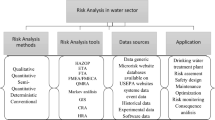Abstract
Selection of sites for the installation of hazardous plants in general and thermal power plants in particular, has assumed significant importance due to excessive air pollution load. Coal-fired power based thermal plants which generate 41% of the world’s electricity are a major source of local pollution and health hazard. It is therefore, important to decide suitable sites for these plants with low risk levels based on formalised mathematical techniques. In this paper, realizing uncertainty in parametric data, authors used fuzzy logic based formalisms, wherein goal in combination with constraints is considered as fuzzy multi constraint optimization problem. The study concludes with identifying optimal ranking of nine thermal power plants in India with ‘low risk’ potential. The limitations of this study have also been outlined.




Similar content being viewed by others
References
Bellman R, Zadeh L (1970) Decision making in a fuzzy environment. J Manag Sci 17:141–164
Central Pollution Control Board (2012) Government of India. http://www.cpcb.nic.in/
Deshpande AW, Yadav JY, Kharat V (2014) Zadeh Deshpande approach for fuzzy description of air and water quality. Int J Inf Technol 6:677–682
Guttikunda S (2011) Coal Kills: an Assessment of Death and Disease caused by India’s Dirtiest Energy Sources. Urban Emissions in partnership with the Conservation Action Trust and Greenpeace India
Kaliraj S, Malar V (2012) Geospatial analysis to assess the potential site for coal based thermal power station in Gujarat. Adv Appl Sci Res India 3(3):1554–1562
Lohani B, Evans JW, Ludwig H, Everitt RR, Carpenter RA, Tu SL (1997) Environmental Impact Assessment for Developing Countries in Asia. Asian Development Bank, Manila
Matrix Thermal Power Pvt. Ltd. (2010) Environment Impact Assessment Report on Coal based washery based Thermal Power Plant, Khammam
Mckone T, Deshpande Ashok W (2005) Can Fuzzy logic Bring Complex Problems into Focus? J Environ Sci Technol 39(2):42A–47A
McKone TE, Deshpande AW (2011) Can fuzzy logic bring complex environmental problems into focus? Environ Sci Technol 15(39):42A–47A
Ministry of Environment and Forest (MoEF) (2011) Guide Lines for Industries and Impact Assessment
Motghare V, Cham R (2014) Generation cost calculation for 547 660 MW thermal power plants. Int J Innov Sci Eng Technol 548:660–664
Narmada Thermal Power Limited (2011) Draft Environmental Impact Assessment Report for Thermal Power Plant, Bharuch, Gujarat, National Environmental Engineering Research, Jaitapur, 2012
NTPC Limited (2010) Badarpur Combined Cycle Power Project, Stage-III, Phase-I (1050 MW) Badarpur, 2010. NTPC, Delhi
Opresnik D, Fiasché M, Taisch M, Hirsch M (2015) An evolving fuzzy inference system for extraction of rule set for planning a product–service strategy. Inf Technol Manag. doi:10.1007/s10799-015-0242-4
Pandey J, Kumar R, Devotta S (2005) Health risks of NO2, SPM and SO2 in Delhi (India). Atmos Environ 39(36):6868–6874
Patel Energy Limited (2011) Draft Environmental Impact Assessment for Coal Based Thermal Power Plant, Amreli
R.S. Envirolink Technologies (2010) GMR Bajoli Holi Hydro Power Plant, Environmental Impact Assessment Report
R.S. Envirolink Technologies (2010) TT Energy, GMR Bajoli Holi Hydro Power Pvt. Ltd., Chamba, Himachal, Environmental Impact Assessment of H.E. Project
Raje DV (2003) Fuzzy logic applications to environment management systems: case studies. In: Proceedings. IEEE International Conference on Industrial Informatics 2003. INDIN 2003
Ross T (1995) Fuzzy logic with engineering application. McGraw Hill, New Mexico
Sambhoo K, Kadam S, Deshpande A (2013) Rule base for grading of sites. Int J Comput Technol 10(7):1836–1847
Sambhoo K, Kadam S, Deshpande A (2014) Efficacy of selected soft computing techniques in ranking of sites for hazardous industrial installation. In: Recent Developments, New Directions in Softcomputing, Studies in Fuzziness and Softcomputing, vol 317. Springer, pp 345–359. ISBN: 978-3-319-06323-2
Shepherd RB (2005) Quantifying environmental impact assessments using fuzzy logic. Springer series on Environmental Management, USA, ISBN: 978-0-387-24398-6
Smec India, SEW Nafra Corporation (2009) Environmental Impact Assessment and Environmental Management Plan for NAFRA Hydro Electric Power Project
Soong TT (1987) Stochastic processes and Stochastic differential equations. In: The Bellman Continuum, pp 551–666
SPIC Electric Power corporation Pvt. Ltd. (2010) HW Tuticorin Thermal Power Project, Tuticorin
Author information
Authors and Affiliations
Corresponding author
Rights and permissions
About this article
Cite this article
Deshpande, A., Sambhoo, K. Can fuzzy logic bring complex issues in risk based optimal ranking of hazardous plant sites into focus? A case study. Int J Syst Assur Eng Manag 8 (Suppl 2), 1079–1089 (2017). https://doi.org/10.1007/s13198-017-0572-1
Received:
Published:
Issue Date:
DOI: https://doi.org/10.1007/s13198-017-0572-1




